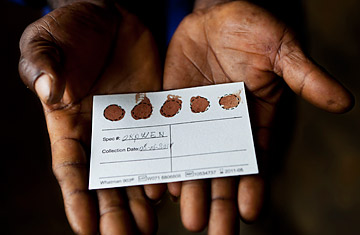
Hunters collect blood from animals they've killed and turn it in for research.
(3 of 6)
In the most basic and ambitious sense, Wolfe's goal is to prevent the next HIV. In 1998, Wolfe, who has a Ph.D. in immunology from Harvard University, published a paper that raised the possible links between the hunting of wild animals and the spread of emerging infectious diseases. At the time, few researchers were exploring that idea, but Burke was one of them. Burke, then at Johns Hopkins, had spent time in Cameroon working on HIV, and he wanted to start a project that could detect when novel viruses were jumping from animals to humans. Wolfe seemed like the perfect person for the job, in part because of his personality. "Nathan has the ability to be very persuasive," says Burke. More important was Wolfe's scientific experience; he'd done research tracking pathogens in primate populations in Malaysia.
Wolfe set up shop in Cameroon in 2000 with barely a word of French--the country is largely francophone--to start what eventually became GVF. He immediately put his persuasiveness to work: Lucky Gunasekara, who runs GVF's digital-epidemiology program and met Wolfe at Stanford, where the virus hunter teaches, told me Wolfe almost instantly talked him into putting medical school on hold and working for him instead. The objective in Cameroon was simple enough: collect blood samples from bush-meat hunters and their prey and find out what microbes were out there. Hunters are what Wolfe calls a sentinel population. "It's amazing the amount of information you can get from a single drop of blood," he says.
The real challenge is getting that blood in the first place, especially in a desperately poor country where the roads range from rough to impassable. GVF distributes filter paper to villages throughout the country; when hunters make a kill, they squeeze a few drops of blood from the animal onto the paper, noting what they butchered, when and where. "We're looking for unknown things," Wolfe says. "If you want to be able to forecast, you need to know what's out there." Every few months, GVF staffers collect the papers, which can preserve blood samples for months. After a decade of work, Wolfe has over 20,000 blood samples.
It didn't take long for the project to pay off. In 2004, Wolfe and his colleagues found evidence that simian foamy virus (SFV) had spread to Cameroonian hunters. SFV--so called because of the way it makes infected cells appear under a microscope--hasn't been connected to any known symptoms, but it was nevertheless worrying that a novel primate retrovirus from the same genetic tree that produced HIV had made the jump to humans. More important, the discovery served as tangible proof that the concept driving GVF was sound. "That was a pivotal moment for this project," says Wolfe. "We knew that this method worked, and if we look for more, we'll find more."
